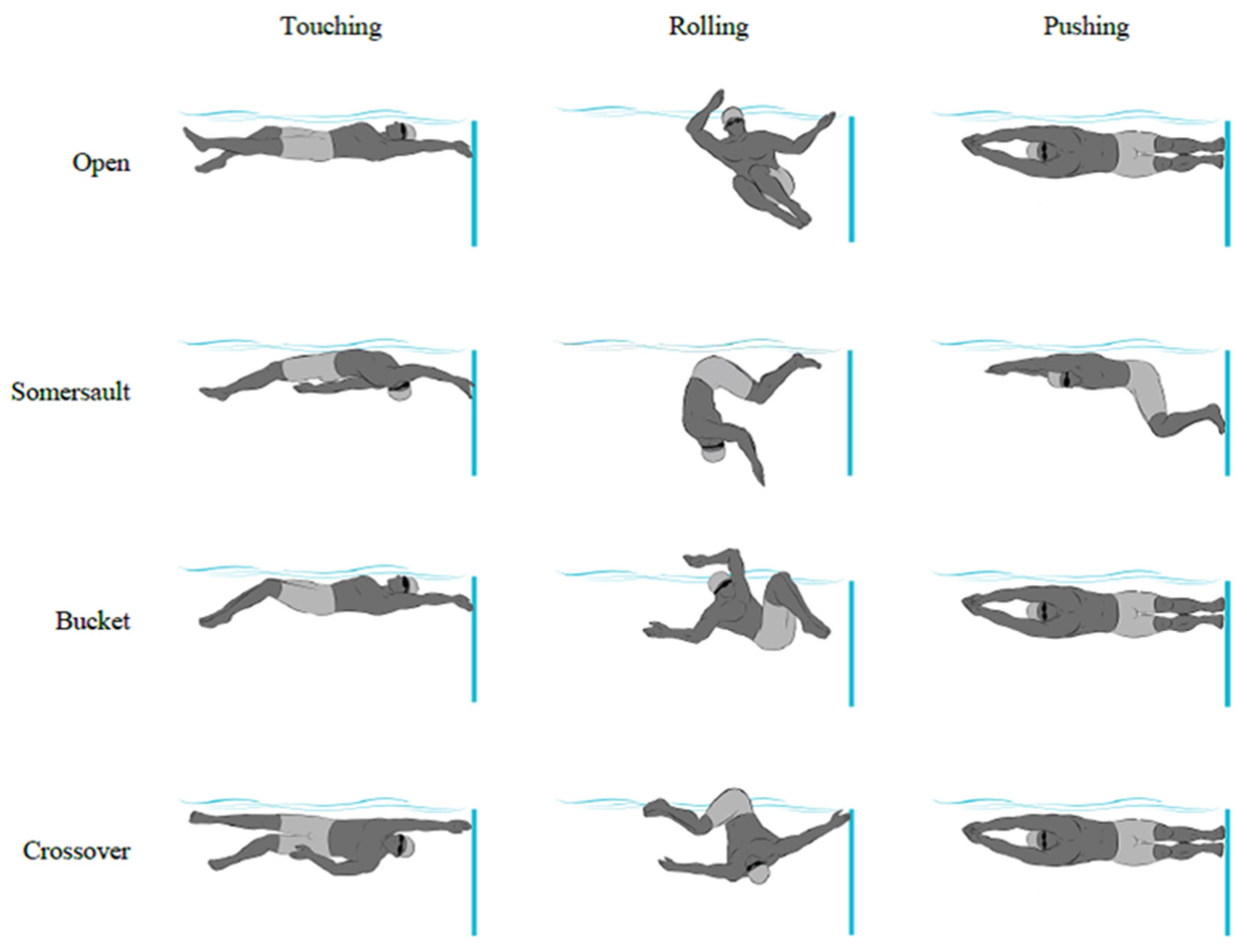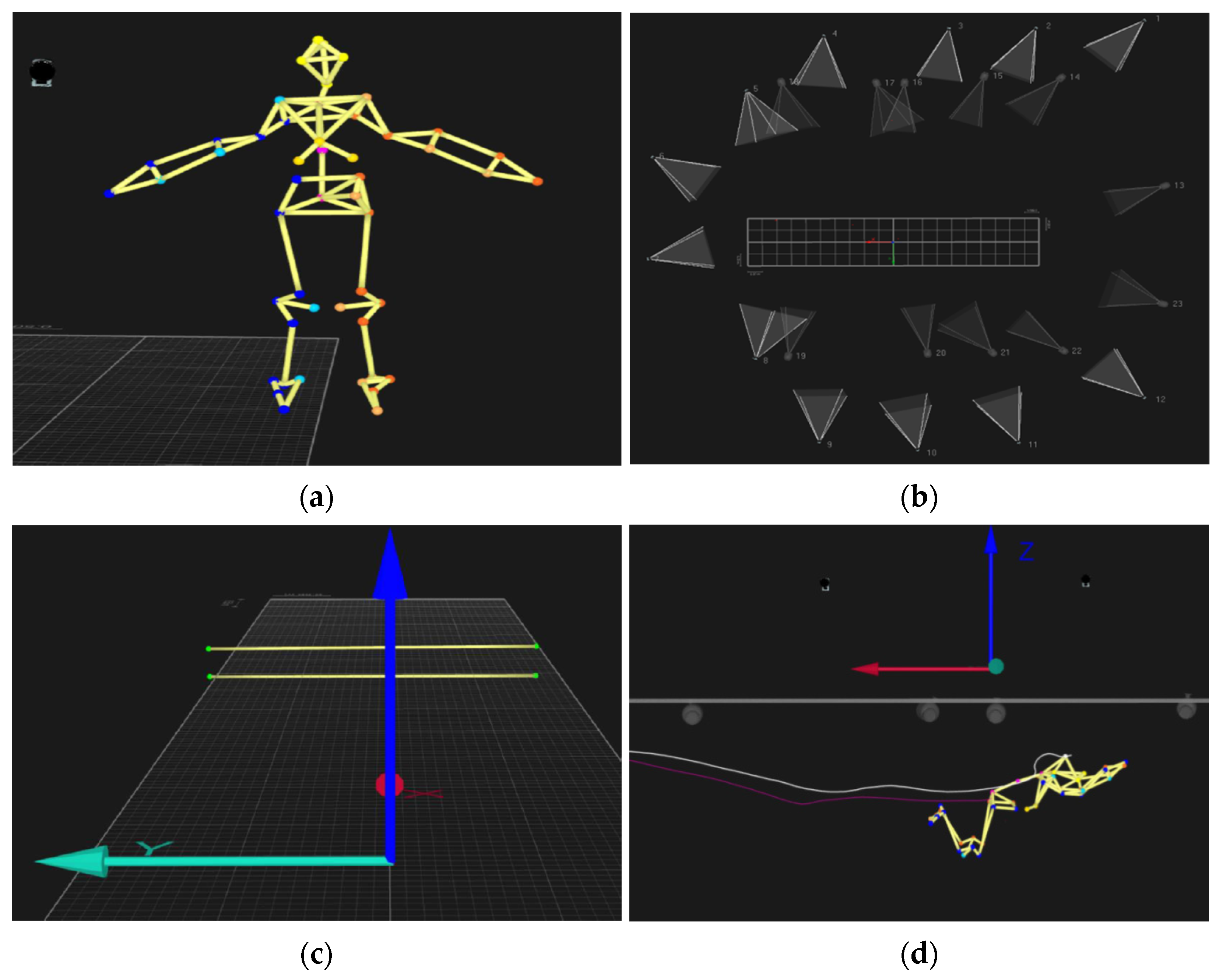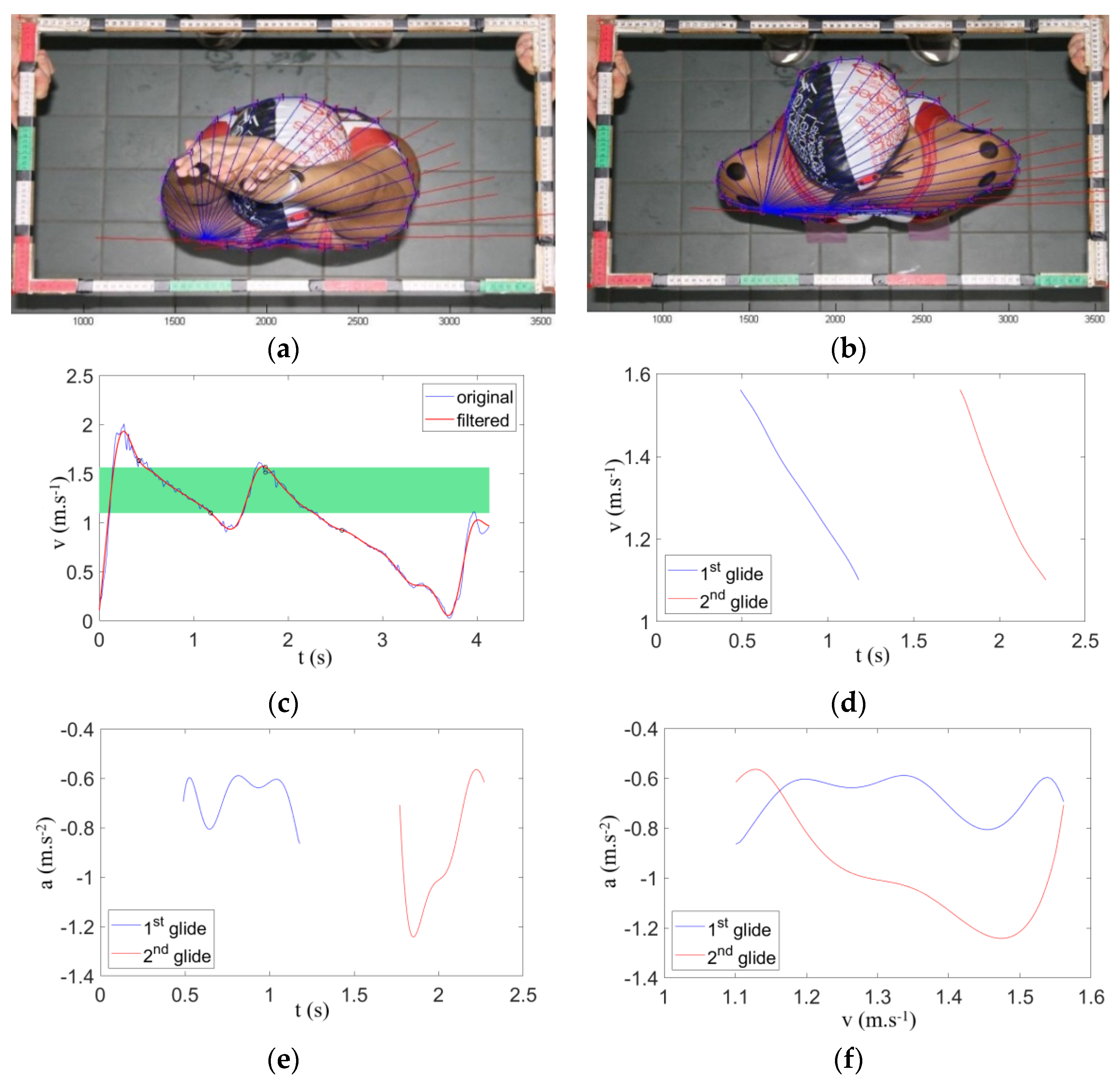Backstroke to Breaststroke Turning Performance in Age-Group Swimmers: Hydrodynamic Characteristics and Pull-Out Strategy
Abstract
1. Introduction
2. Materials and Methods
2.1. Experimental Approach
2.2. Participants
2.3. Measurements
2.4. Data Processing
2.5. Statistical Analysis
3. Results
4. Discussion
5. Conclusions
Author Contributions
Funding
Institutional Review Board Statement
Informed Consent Statement
Data Availability Statement
Acknowledgments
Conflicts of Interest
References
- Blanksby, B.; Skender, S.; Elliott, B.; McElroy, K.; Landers, G. An analysis of the rollover backstroke turn by age-group swimmers. Sports Biomech. 2004, 3, 1–14. [Google Scholar] [CrossRef] [PubMed]
- Webster, J.; West, A.; Conway, P.; Cain, M. Development of a pressure sensor for swimming turns. Procedia Eng. 2011, 13, 126–132. [Google Scholar] [CrossRef][Green Version]
- Pereira, S.M.; Ruschel, C.; Hubert, M.; Machado, L.; Roesler, H.; Fernandes, R.J.; Vilas-Boas, J.P. Kinematic, kinetic and EMG analysis of four front crawl flip turn techniques. J. Sports Sci. 2015, 33, 2006–2015. [Google Scholar] [CrossRef] [PubMed]
- Lyttle, A.D.; Blanksby, B.A.; Elliott, B.C.; Lloyd, D.G. Net forces during tethered simulation of underwater streamlined gliding and kicking techniques of the freestyle turn. J. Sports Sci. 2000, 18, 801–807. [Google Scholar] [CrossRef] [PubMed]
- Prins, J.H.; Patz, A. The influence of tuck index, depth of foot-plant, and wall contact time on the velocity of push-off in the freestyle flip turn. Port. J. Sport Sci. 2006, 6, 82–85. [Google Scholar]
- Naemi, R.; Easson, W.J.; Sanders, R.H. Hydrodynamic glide efficiency in swimming. J. Sci. Med. Sport 2010, 13, 444–451. [Google Scholar] [CrossRef]
- Peterson Silveira, R.; Soares, S.M.; Zacca, R.; Alves, F.B.; Fernandes, R.J.; Castro, F.A.d.S.; Vilas-Boas, J.P. A Biophysical Analysis on the Arm Stroke Efficiency in Front Crawl Swimming: Comparing Methods and Determining the Main Performance Predictors. Int. J. Environ. Res. Public Health 2019, 16, 4715. [Google Scholar] [CrossRef]
- Chatard, J.; Bourgoin, B.; Lacour, J. Passive drag is still a good evaluator of swimming aptitude. Eur. J. Appl. Physiol. Occup. Physiol. 1990, 59, 399–404. [Google Scholar] [CrossRef]
- Lyttle, A.D.; Blanksby, B.A.; Elliott, B.C.; Lloyd, D.G. Investigating kinetics in the freestyle flip turn push-off. J. Appl. Biomech. 1999, 15, 242–252. [Google Scholar] [CrossRef]
- Novais, M.; Silva, A.; Mantha, V.; Ramos, R.; Rouboa, A.; Vilas-Boas, J.; Luís, S.; Marinho, D. The effect of depth on drag during the streamlined glide: A three-dimensional CFD analysis. J. Hum. Kinet. 2012, 33, 55–62. [Google Scholar] [CrossRef]
- Clarys, J.P. Human morphology and hydrodynamics. In Swimming III; Terauds, J., Bedingfield, E.W., Eds.; University Park Press: Baltimore, MD, USA, 1979; pp. 3–41. [Google Scholar]
- Havriluk, R. Performance level differences in swimming: A meta-analysis of passive drag force. Res. Q. Exerc. Sport 2005, 76, 112–118. [Google Scholar] [CrossRef]
- Clarys, J.P. An experimental investigation of the application of fundamental hydrodynamics to the human body. In Swimming Medicine IV; Eriksson, B., Furberg, B., Eds.; University Park Press: Baltimore, MD, USA, 1978; pp. 386–394. [Google Scholar]
- Vilas-Boas, J.P.; Costa, L.; Fernandes, R.J.; Ribeiro, J.; Figueiredo, P.; Marinho, D.; Silva, A.J.; Rouboa, A.; Machado, L. Determination of the drag coefficient during the first and second gliding positions of the breaststroke underwater stroke. J. Appl. Biomech. 2010, 26, 324–331. [Google Scholar] [CrossRef] [PubMed]
- Zamparo, P.; Gatta, G.; Pendergast, D.; Capelli, C. Active and passive drag: The role of trunk incline. Eur. J. Appl. Physiol. 2009, 106, 195–205. [Google Scholar] [CrossRef] [PubMed]
- Costa, L.; Mantha, V.; Silva, A.; Fernandes, R.J.; Marinho, D.; Vilas-Boas, J.P.; Machado, L.; Rouboa, A. Computational fluid dynamics vs. inverse dynamics methods to determine passive drag in two breaststroke glide positions. J. Biomech. 2015, 48, 2221–2226. [Google Scholar] [CrossRef] [PubMed]
- Maglischo, E.W. Swimming Fastest; Mayfield Publishing Company: Mountain View, CA, USA, 2003. [Google Scholar]
- Alcock, A. The effect of pullout timing on breaststroke turn performance. In Proceedings of the 12th International Symposium for Biomechanics and Medicine in Swimming, Canberra, Australia, 28 April–2 May 2014; pp. 70–74. [Google Scholar]
- Jeffreys, I. Motor learning-applications for agility, part 1. Strength Cond. J. 2006, 28, 72. [Google Scholar]
- Guadagnoli, M.A.; Lee, T.D. Challenge point: A framework for conceptualizing the effects of various practice conditions in motor learning. J. Mot. Behav. 2004, 36, 212–224. [Google Scholar] [CrossRef]
- Lauer, J.; Rouard, A.H.; Vilas-Boas, J.P. Upper limb joint forces and moments during underwater cyclical movements. J. Biomech. 2016, 49, 3355–3361. [Google Scholar] [CrossRef] [PubMed]
- Lauer, J.; Rouard, A.H.; Vilas-Boas, J.P. Modulation of upper limb joint work and power during sculling while ballasted with varying loads. J. Exp. Biol. 2017, 220, 1729–1736. [Google Scholar] [CrossRef]
- Levine, T.R.; Hullett, C.R. Eta squared, partial eta squared, and misreporting of effect size in communication research. Hum. Commun. Res. 2002, 28, 612–625. [Google Scholar] [CrossRef]
- Cohen, J. Set correlation and contingency tables. Appl. Psychol. Meas. 1988, 12, 425–434. [Google Scholar] [CrossRef]
- Benjanuvatra, N.; Blanksby, B.A.; Elliott, B.C. Morphology and hydrodynamic resistance in young swimmers. Pediatr. Exerc. Sci. 2001, 13, 246–255. [Google Scholar] [CrossRef]
- Ling, B.H.; Blanksby, B.A.; Elliott, B.C.; McElroy, G.K. A force–time characteristic of the butterfly turns by age group swimmers. J. Hum. Mov. Stud. 2004, 47, 429–451. [Google Scholar]
- Blanksby, B.A.; Simpson, J.R.; Elliott, B.C.; McElroy, K. Biomechanical factors influencing breaststroke turns by age-group swimmers. J. Appl. Biomech. 1998, 14, 180–189. [Google Scholar] [CrossRef]
- Blanksby, B.; Gathercole, D.; Marshall, R. Force plate and video analysis of the tumble turn by age-group swimmers. J. Swim. Res. 1996, 40–45. [Google Scholar]
- Araujo, L.; Pereira, S.; Gatti, R.; Freitas, E.; Jacomel, G.; Roesler, H.; Villas-Boas, J. Analysis of the lateral push-off in the freestyle flip turn. J. Sports Sci. 2010, 28, 1175–1181. [Google Scholar] [CrossRef]
- Lyttle, A.D.; Blanksby, B.; Elliot, B.; Lloyd, D.G. The effect of depth and velocity on drag during the streamlined guide. J. Swim. Res. 1998, 13, 15–22. [Google Scholar]
- Sanders, R.; Byatt-Smith, J. Improving feedback on swimming turns and starts exponentially. In Proceedings of the 19 International Conference of Biomechanics in Sport, San Francisco, CA, USA, 20–26 June 2001; pp. 91–95. [Google Scholar]
- Termin, B.; Pendergast, D.R. How to optimize performance. Swim. Tech. 1998, 34, 41–46. [Google Scholar]



| Variables | Definition |
|---|---|
| Push-off velocity | Sacrum resultant velocity at the moment the feet left the wall. |
| Tuck index | Right hip distance from the wall at the beginning of push-off divided by the swimmer’s lower limb length. |
| Foot plant index | Foot plant depth on the wall at the beginning of push-off divided by the swimmer’s lower limb length. |
| First gliding distance | Sacrum distance from the moment the feet left the wall to the transition phase’s beginning. |
| First gliding time | Sacrum time from the beginning of the feet leaving the wall to the transition phase’s beginning. |
| First gliding depth | Sacrum average depth during the first gliding. |
| Transition distance | Sacrum distance from the initial hand separation or start of dolphin lower limb action until the upper limbs are extended at the body’s sides. |
| Transition time | Sacrum time from the initial hand separation or starting dolphin lower limb action until the upper limbs are extended at the body’s sides. |
| Transition gliding depth | Sacrum average depth during the transition phase. |
| Second gliding distance | Sacrum distance from the first frame of the upper limbs being extended at body’s sides to the instant the hands begin to move up from the body’s sides. |
| Second gliding time | Sacrum time from the first frame of the upper limbs being extended at the body’s sides to the instant the hands begin to move up from the body’s sides. |
| Second gliding depth | Sacrum average depth during the second gliding. |
| Breakout distance | Distance at which the head breaks the surface for the first time. |
| Breakout time | Time at which the head breaks the surface for the first time. |
| Average pull-out velocity | Average velocity from the moment the feet leave the wall to the head breaking the surface. |
| Time to 7.5 m | Time from the feet leaving the wall to the head reaching the 7.5 m mark. |
| Variables | Turning Techniques | p | ω2 | ||||
|---|---|---|---|---|---|---|---|
| Open | Somersault | Bucket | Crossover | All | |||
| V1st (m·s−1) | 1.31 ± 0.14 | 1.33 ± 0.13 | 1.32 ± 0.12 | 1.32 ± 0.15 | 1.32 ± 0.13 | 0.89 | 0.001 |
| V2nd (m·s−1) | 1.31 ± 0.02 | 1.33 ± 0.02 | 1.32 ± 0.02 | 1.32 ± 0.02 | 1.32 ± 0.13 | 0.89 | 0.001 |
| CD1st | −0.74 ± 0.16 | −0.72 ± 0.27 | −0.74 ± 0.30 | −0.75 ± 0.14 | −0.74 ± 0.22 | 0.90 | 0.001 |
| CD2nd | −1.14 ± 0.44 | −1.12 ± 0.34 | −1.17 ± 0.47 | −1.27 ± 0.51 | −1.18 ± 0.45 | 0.17 | 0.01 |
| D1st (N) | −36.73 ± 9.99 | −39.01 ± 13.48 | −40.28 ± 9.75 | −41.78 ± 7.10 | −39.35 ± 0.67 | 0.08 | 0.02 |
| D2nd (N) | −61.65 ± 5.76 | −64.13 ± 5.42 | −62.25 ± 12.34 | −69.73 ± 16.55 | −64.44 ± 15.11 | 0.25 | 0.001 |
| Variables | Turning Techniques | p | ω2 | ||||
|---|---|---|---|---|---|---|---|
| Open | Somersault | Bucket | Crossover | All | |||
| Push-off velocity (m·s−1) | 2.03 ± 0.04 c | 2.02 ± 0.05 c | 2.01 ± 0.04 c | 2.17 ± 0.05 o,s,b | 2.06 ± 0.03 | 0.01 | 0.05 |
| Tuck index | 0.71 ± 0.14 s | 0.76 ± 0.10 o | 0.76 ± 0.09 | 0.72 ± 0.12 | 0.74 ± 0.12 | 0.09 | 0.00 |
| Foot plant index | 0.59 ± 0.02 c | 0.68 ± 0.03 b,c | 0.55 ± 0.03 s | 0.50 ± 0.02 o,s | 0.58 ± 0.19 | 0.01 | 0.11 |
| First gliding distance (m) | 2.41 ± 0.56 | 2.60 ± 0.64 | 2.48 ± 0.58 | 2.44 ± 0.63 | 2.47 ± 0.65 | 0.07 | 0.02 |
| First gliding time (s) | 1.21 ± 0.42 | 1.34 ± 0.49 | 1.32 ± 0.38 | 1.29 ± 0.3.78 | 1.28 ± 0.45 | 0.18 | 0.01 |
| First gliding depth (m) | 0.56 ± 0.13 s | 0.73 ± 0.13 o,b,c | 0.57 ± 0.13 s | 0.57 ± 0.13 s | 0.61 ± 0.15 | 0.01 | 0.25 |
| Transition distance (s) | 1.09 ± 0.20 | 1.08 ± 0.22 | 1.10 ± 0.14 | 1.09 ± 0.19 | 1.09 ± 0.02 | 0.75 | 0.00 |
| Transition time (s) | 0.99 ± 0.22 | 0.92 ± 0.19 | 0.97 ± 0.16 | 0.96 ± 0.18 | 0.96 ± 0.19 | 0.23 | 0.01 |
| Transition gliding depth (m) | 0.62 ± 0.14 s | 0.86 ± 0.17 o,b,c | 0.67 ± 017 s | 0.65 ± 0.16 s | 0.70 ± 0.20 | 0.01 | 0.29 |
| Second gliding distance (m) | 0.78 ± 0.27 | 0.82 ± 0.34 | 0.86 ± 0.27 | 0.85 ± 0.32 | 0.85 ± 0.28 | 0.44 | 0.00 |
| Second gliding time (s) | 0.78 ± 0.03 | 0.83 ± 0.05 | 0.86 ± 0.05 | 0.85 ± 0.05 | 0.83 ± 0.30 | 0.19 | 0.01 |
| Second gliding depth (m) | 0.62 ± 0.17 s | 0.76 ± 0.17 o,b,c | 0.62 ± 0.16 s | 0.62 ± 0.15 s | 0.65 ± 0.18 | 0.01 | 0.14 |
| Breakout distance (m) | 5.97 ± 0.87 | 6.13 ± 0.94 | 6.05 ± 0.80 | 6.02 ± 0.91 | 6.04 ± 0.94 | 0.85 | 0.00 |
| Breakout time (s) | 4.84 ± 0.94 | 5.01 ± 0.96 | 4.83 ± 0.84 | 4.78 ± 0.91 | 4.86 ± 0.98 | 0.42 | 0.00 |
| Average pull-out velocity (m·s−1) | 1.06 ± 0.13 | 1.08 ± 0.14 | 1.08 ± 0.14 | 1.07 ± 0.12 | 1.07 ± 0.13 | 0.74 | 0.00 |
| Time to 7.5 m (m) | 7.19 ± 0.89 | 7.09 ± 0.91 | 7.06 ± 0.72 | 7.12 ± 0.82 | 7.12 ± 0.90 | 0.75 | 0.00 |
Publisher’s Note: MDPI stays neutral with regard to jurisdictional claims in published maps and institutional affiliations. |
© 2021 by the authors. Licensee MDPI, Basel, Switzerland. This article is an open access article distributed under the terms and conditions of the Creative Commons Attribution (CC BY) license (http://creativecommons.org/licenses/by/4.0/).
Share and Cite
Chainok, P.; Machado, L.; de Jesus, K.; Abraldes, J.A.; Borgonovo-Santos, M.; Fernandes, R.J.; Vilas-Boas, J.P. Backstroke to Breaststroke Turning Performance in Age-Group Swimmers: Hydrodynamic Characteristics and Pull-Out Strategy. Int. J. Environ. Res. Public Health 2021, 18, 1858. https://doi.org/10.3390/ijerph18041858
Chainok P, Machado L, de Jesus K, Abraldes JA, Borgonovo-Santos M, Fernandes RJ, Vilas-Boas JP. Backstroke to Breaststroke Turning Performance in Age-Group Swimmers: Hydrodynamic Characteristics and Pull-Out Strategy. International Journal of Environmental Research and Public Health. 2021; 18(4):1858. https://doi.org/10.3390/ijerph18041858
Chicago/Turabian StyleChainok, Phornpot, Leandro Machado, Karla de Jesus, J. Arturo Abraldes, Márcio Borgonovo-Santos, Ricardo J. Fernandes, and João Paulo Vilas-Boas. 2021. "Backstroke to Breaststroke Turning Performance in Age-Group Swimmers: Hydrodynamic Characteristics and Pull-Out Strategy" International Journal of Environmental Research and Public Health 18, no. 4: 1858. https://doi.org/10.3390/ijerph18041858
APA StyleChainok, P., Machado, L., de Jesus, K., Abraldes, J. A., Borgonovo-Santos, M., Fernandes, R. J., & Vilas-Boas, J. P. (2021). Backstroke to Breaststroke Turning Performance in Age-Group Swimmers: Hydrodynamic Characteristics and Pull-Out Strategy. International Journal of Environmental Research and Public Health, 18(4), 1858. https://doi.org/10.3390/ijerph18041858










